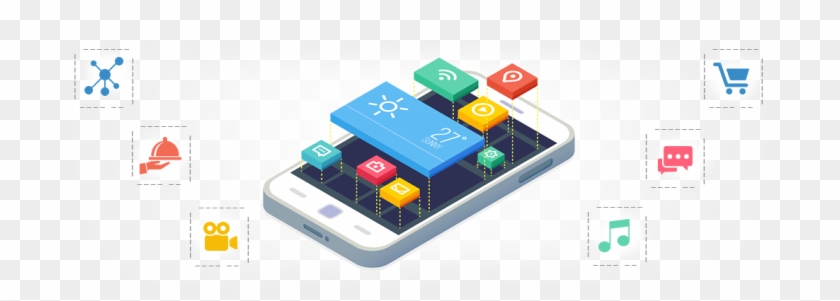Crafting a digital experience has become an art form in today’s tech-driven world. As mobile apps continue to dominate our daily lives, software design and development play a paramount role in creating seamless and impactful experiences for users. From banking and shopping to entertainment and productivity, mobile applications have revolutionized the way we interact with technology. However, behind every successful mobile app lies a thoughtfully designed and meticulously developed software that caters to the specific needs and preferences of its target audience.
Software design and development encompass a diverse range of disciplines, combining aesthetics, functionality, and user experience to create remarkable mobile applications. The process begins with understanding the goal and purpose of the app, followed by meticulous planning and strategizing. An important aspect of software design and development is identifying the types of mobile applications that are most suitable for the intended audience. Whether it’s a gaming app, a social networking platform, a utility tool, or an e-commerce solution, each type requires a unique approach in terms of design and development.
With the rise of smartphones and the ever-increasing demand for mobile applications, software design and development have evolved into a dynamic and highly competitive field. Developers are constantly pushing the boundaries to create innovative and user-centric apps that stand out in the crowded marketplace. From intuitive user interfaces to seamless navigation and personalized experiences, the success of a mobile app heavily relies on the intricate details of its design and the robustness of its development.
In this article, we will delve into the fascinating world of software design and development, exploring the different types of mobile applications and their unique design considerations. We will also discuss the pivotal role of user experience (UX) design in creating intuitive and engaging interfaces. So buckle up and join us on a journey to unleash the power of software design and development, as we unravel the intricacies behind crafting exceptional digital experiences.
Mobile App Development: A Brief Overview
With the ever-increasing popularity of smartphones and tablets, the demand for mobile applications has skyrocketed in recent years. From social networking and gaming to productivity and entertainment, mobile apps have become an integral part of our daily lives. In this section, we will provide a brief overview of mobile app development and explore the fascinating world of software design and development.
Mobile app development involves the creation of software applications specifically designed to operate on mobile devices. These applications can be developed for various platforms, including iOS, Android, and Windows Phone, each with its own unique development framework and programming language. Whether it’s crafting a sleek and intuitive user interface or optimizing performance for different screen sizes, mobile app developers face numerous challenges to ensure a seamless and engaging user experience.
There are various types of mobile applications that cater to different needs and interests. For instance, native apps are developed specifically for a particular platform and take full advantage of its features and capabilities. On the other hand, hybrid apps are built using web technologies like HTML, CSS, and JavaScript, allowing developers to create a single app that can run across multiple platforms. Additionally, there are web apps that are accessed through a mobile browser and do not require installation.
In this fast-paced digital landscape, mobile applications have become indispensable tools for businesses, entrepreneurs, and individuals alike. Whether you’re ordering food, booking a ride, or managing your finances, mobile apps provide convenience and accessibility at your fingertips. As technology continues to evolve, the field of mobile app development will undoubtedly witness exciting advancements, pushing the boundaries of software design and development even further. Stay tuned for the next section where we will delve deeper into the key principles and processes involved in crafting exceptional mobile experiences.
The Importance of Software Design in Mobile App Development
In the realm of mobile app development, software design plays a vital role. It lays the foundation for creating exceptional mobile applications that captivate users and deliver seamless experiences. As the demand for innovative mobile apps continues to grow, paying attention to the design aspect becomes crucial in order to stand out from the competition.
Effective software design is key to ensuring that mobile apps are not only visually appealing but also highly functional and user-friendly. By carefully considering the user interface (UI) and user experience (UX), developers can create intuitive and engaging mobile applications that cater to the needs and preferences of their target audience.
When it comes to designing mobile apps, various factors come into play. One important aspect is choosing the right navigation flow and layout, allowing users to easily navigate through different sections of the app without confusion or frustration. Additionally, considering the visual elements, such as color schemes, fonts, and graphics, can greatly enhance the overall aesthetics of the mobile app.
Moreover, software design contributes to the overall performance and efficiency of the app. Through effective design principles, developers can optimize the app’s loading times, responsiveness, and accessibility across different devices and platforms. By ensuring smooth functionality and avoiding unnecessary complications, users are more likely to have a positive experience with the app, leading to higher user engagement and satisfaction.
In summary, software design forms the backbone of mobile app development. By focusing on creating visually pleasing, intuitive, and efficient mobile applications, developers can unlock the potential to deliver exceptional digital experiences to their users. A well-designed mobile app not only attracts users but also keeps them coming back for more, helping businesses establish their presence in the ever-growing mobile landscape.
Exploring Different Types of Mobile Applications
-
Social Networking Apps:

Social networking apps have become an integral part of our daily lives. These apps allow users to connect, interact, and share content with friends, family, and acquaintances. With features like messaging, photo sharing, and status updates, social networking apps offer a platform for users to stay connected and engaged in real time. - Native mobile apps explained
Gaming Apps:
Gaming apps have gained immense popularity in recent years. These apps offer a diverse range of entertainment with various genres like puzzle, adventure, simulation, and strategy games. Whether it’s a quick break or a long gaming session, these apps provide users with an immersive and interactive experience, often with stunning visuals and engaging gameplay. -
Lifestyle Apps:
Lifestyle apps cater to diverse needs and interests of users. They encompass a wide range of categories, including health and fitness, travel, food, fashion, and more. These apps offer valuable resources, information, and services that enhance and simplify various aspects of our daily lives. Whether it’s tracking fitness goals or finding the latest fashion trends, lifestyle apps serve as our personal assistants, delivering tailored content and experiences.
Remember, these three paragraphs are part of the article titled "The Art of Crafting Digital Experiences: Unleashing the Power of Software Design and Development" which explores the world of software design and development, with a specific focus on mobile applications.
